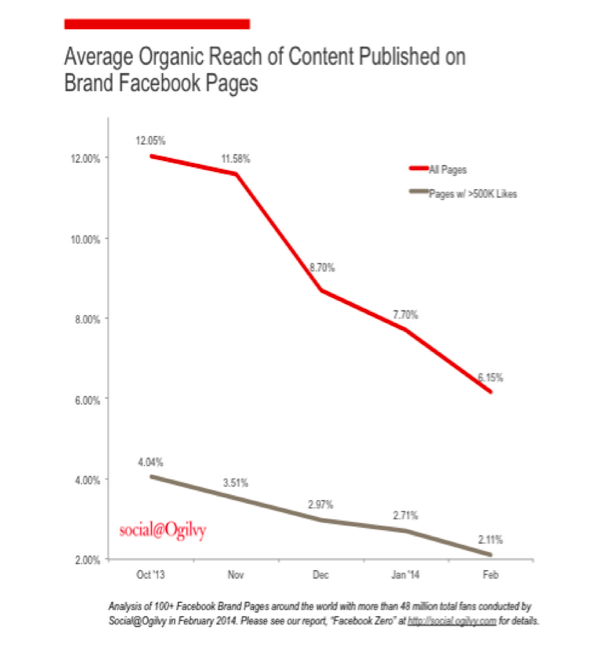Wondering how, as a marketer, you can survive Facebook with all their recent changes in 2014?
If not, you should be. Building an online community is a critical feature that played into the popularity of Facebook as a marketing tool. Easy engagement and massive reach prompted businesses to invest in fan pages as a way to communicate with their audience. If you need more convincing, read our post on Big Strategies for Small Budgets.
But if you've already taken the time to build your following on Facebook, and you already have a solid number of followers, you might have noticed a significant decline in the number of people who are seeing your posts.
Blame it on Facebook’s new algorithm that determines what users see on their newsfeeds. Since it launched, organic reach has whittled down to 6%, from a peak of almost 50% only six months ago. By the end of the year, don’t be surprised if organic reach goes down to less than 1 percent.

Monetizing this feature makes sense for Facebook as a business entity; as a marketing tool however, it’s kind of new territory.
Facebook tries its best to explain it all here—but it still raises a lot of questions:
- Does this mean that Facebook is no longer a driver of word-of-mouth and is now a paid ad platform?
- Does it still make sense to invest in Facebook for online marketing?
- Can Facebook still drive engagement and interest for your brand?
- Should you now change your approach to Facebook marketing?
Here’s my take on it…
The decline of organic reach simply means you now have to pay for content that you want your followers to notice.
BUT… that doesn't mean you have to break the bank to make a difference in terms of reach; you just have to be smarter about it.
For instance—
1. Share And Invest In Shareworthy Content
Whether it’s from an organic or promoted perspective, the rule is the same—you have to share content that is worth sharing.
Remember that it is in Facebook’s interest to have engagement on a site that is meant to engage—which means they have to maintain it as a place where people interact.
With that said, no one really knows what qualifications Facebook seeks when it comes to deciding what lands on newsfeeds. But once in a while, something you post will get picked up.
I think early engagement plays a big part of it. Try testing various types of Facebook content and track its impact in terms of capturing audience interest. If it gets relatively high engagement, you might want to create and invest more in this type of content.
2. Focus On Timing
Consider when you publish your posts.
You’re already investing in your posts, make sure that your audience sees them!
For instance, if you’re communicating to students, it won’t really make sense to publish your posts during school hours when kids are in class.
Are you trying to spark interest for a pub?
Try posting it early in the evening instead or first thing in the morning.
Observe when you get the most engagement and be sure to keep your content flowing around those times.
3. Consider “Social Drafting”
Original content is great and should be a priority when it comes to social sharing (especially when you’re paying for it). But once in a while, something goes viral online and it would make perfect sense to piggyback on it by sharing it on your page.
This works best if what your sharing is related to what your business is all about so don’t just ride on whatever is viral at the moment.
Keep these in mind as you navigate through Facebook’s new rules.
Remember, investing in anything that can help you brand, like new promotions and anything that is time sensitive will help promote your business. On the other hand, things that you want people to see but doesn’t really make or break you—these are things that you can rely on organic reach for.
Let’s get things rolling with this Seriously Simple Marketing Hack—

Now would be a great time to put Facebook’s trending topics feature to good use.
1. Browse through the list of trending topics on Facebook and choose a subject that you think would catch the interest of your followers.
2. Repost it on your own page making sure that:
- You have a catchy headline
- You have appropriate visuals to go with it (steer clear of stock photos if you can)
- Bring focus to the social buttons at your disposal by making a clear call to action.
3. Keep doing this throughout the week across different times while keeping track of your rate of engagement so you can find out when the best time to engage your audiences will be.
– Mercer
Our SlideShare Slides:
